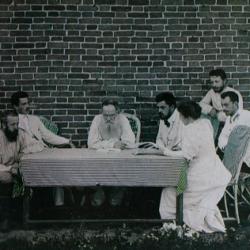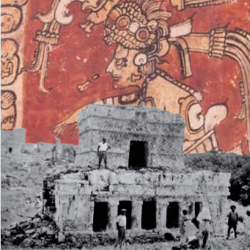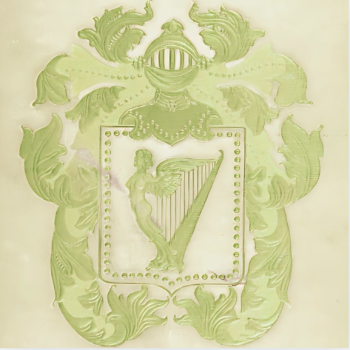MAHARANI SWARNAMOYEE
One of the first acts of official business Johnston was assigned, was overseeing a land purchase by the Maharani Swarnamoyee (1827–1897.) A household name in Bengal, Swarnamoyee was “synonymous with all that is noble and good in woman.” Her generous donations for the purposes of education (particularly education of women,) and social services (which benefited everyone, regardless of caste and creed,) endeared her to many. Her charitable donations extended to the Theosophical Society. As soon as Blavatsky and Olcott arrived in India, the Maharani became a patron of the library fund at Adyar.[1] Presently Swarnamoyee was in the process of finalizing her purchase of an estate known as Mouza Hatzore.[2]

Carved arches in the palace of the Maharani of Kasimbazar.[3]
Born in 1838 in the small village of Bhakatal, the illiterate, eleven-year-old Swarnamoyee came into the Kasimbazar family by marriage, as the wife of Prince Kumar Krisnanath, the last of the direct line from Krishna Kanta Nandy. The name Swarnamoyee (the golden girl,) did not satisfy her new guardians, so after the wedding they changed it to Saradasundari (the goddess Saraswati and/or her mother Durga,) “ringing in harmony with Harasundari (her mother-in-law,) and Gobindasundari (her sister-in-law.) The young princess bore the prince two daughters, the first when she was fourteen, and the second, at seventeen. The second child was born after the death of her husband, who took his life with a pistol in 1844.[4] Swarnamoyee’s late-husband did not make concessions for her to choose an heir, and the questionable wording of his will suggested that their estate was bequeathed to the East India Company (EIC.)
The Collector of Murshidabad, acting in the interest of the EIC, moved to take charge of the family’s estates in Kasimbazar and Banjetia. Under the instructions from the Collector, the house was broken into through the khidki (back door,) the women were forced into another room. All the valuables found there, were listed, boxed and carried away to the Collector’s office. This later became the subject of a suit, which Rani Swarnamoyee instituted, and won, against the Collector.
Swarnamoyee realized her illiteracy would handicap the aspirations of the responsibility she wished to assume. By sheer strength of will, perseverance, and industry, she mastered Bengali, and had working knowledge in English, Persian and Sanskrit. She created two libraries in her palace and educated herself by reading newspapers and books. After learning the zemindari system from her Dewan (Mathuranath Bannerji,) Swarnamoyee visited her properties to see, firsthand, how things operated. Carefully synthesizing her accumulated knowledge, pruning a great deal of unnecessary rituals, and contributing her own personal beliefs, she created “an almost perfect system of administration.” Laboring tirelessly for succession to her lawful inheritance and raising the prestige of her family to a level never before seen, Swarnamoyee single-handedly doubled the income of the Kasimbazar Raj Estate. Swarnamoyee would lose her two daughters, and her two granddaughters, but undeterred by personal grief, she carried on her duties “with quiet strength and unfaltering persistence—the duties of a benevolent zemindar and a pious Hindu widow.” Her beneficence and loyalty were eventually rewarded with the conferral of the title of Maharani (Great Queen,) by Queen Victoria. As a further reward, Swarnamoyee was allowed to name her heir, and the hereditary title of Maharaja was revived for her nephew, Manindra Chandra Nandy.[5]
← Table Of Contents →
SOURCES:
[1] Ghose, Shish Kumar. “The Origin Of Theosophy In India” The Hindu Spiritual Magazine Vol. III, No. 12. (February 1909): 422-428; Olcott, Henry Steel. Old Diary Leaves: Volume V. Theosophical Publishing House. Adyar, India. (1932): 27.
[2] “[Swarnamoyee] brought her expertise in Revenue sale proceedings to increase her properties there. Ballia no longer remained an island but joined the mainstream of administration. On 20 March 1876, Swarnamoyee bought in Revenue sale the Ganeshpur zemindari for Rs. 50, Mouza Sabeya for Rs. 50, mahal Narayanpur for Rs. 20, mahal Bhagwanpur for Rs. 10, mahal Patishai for Rs. 15, mahal Tajpur for Rs. 25 and mahal Gopalpur for Rs. 25. Thus for Rs. 195 she acquired rights over a troublesome group of tenants, who in spite of their bad reputation never defaulted her payments which was about Rs. 1000 per annum. On 20 November 1878, she bought Hatzore zemindari in Revenue sale for Rs. 11,000 in spite of the stiff opposition of the neighboring zemindars who had been shaken out of their slumber by her since 1876. Swarnamoyee however felt that the bad feeling of the surrounding zemindars might create difficulties for her administration as she would be living 500 miles away. She therefore did not purchase any property for some time, coming back suddenly to buy the rest of Mouza Hatzore, in Revenue sale on 4 March 1889 for Rs. 2474-6-6. which consolidated her position, She also bought in Revenue sale the zemindari of Bansdih on 29 June 1889, for Rs. 462, for which she had to go a little further and deeper into the Muffasil.” Nandy, Somendra Chandra. History Of The Cossimbazar Raj Vol. 1. P.K. Roy. Calcutta, India. (1957): 452-453.
[3] W.C. “Some Transactions Of The C.H.S.” Bengal: Past & Present. Vol. II, No. 2 (April, 1908): 191-210.
[4] Nandy, Somendra Chandra. History Of The Cossimbazar Raj Vol. 1. P.K. Roy. Calcutta, India. (1957): 282-283.
[5] Nandy, Somendra Chandra. History Of The Cossimbazar Raj Vol. 1. P.K. Roy. Calcutta, India. (1957): xi-xii, xiv, 204, 286, 294, 300, 441; Walsh, History Of Murshidabad, 208.













